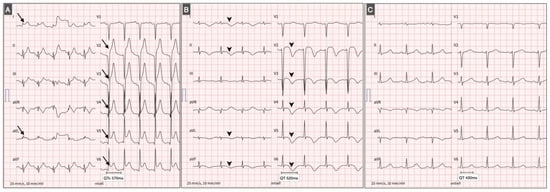- Case Report
A Didactic Case of Long QT Associated with Pheochromocytoma
- Selma T. Cook and
- Malica Cook
Long QT associated with pheochromocytoma is rare but clinically significant. A 43-year-old woman presented with palpitations, chest pain, and recurrent syncope. ECG showed ST-segment elevation, while coronary angiography revealed normal arteries but Takotsubo-like left ventricular dysfunction. Hypertension and tachycardia raised suspicion for pheochromocytoma, later confirmed by imaging and biochemical tests. The patient exhibited QT prolongation (QTc 570 ms) in parallel with Takotsubo episodes. Following adrenalectomy, both QT duration and ventricular function normalized. The European Society of Cardiology now classifies pheochromocytoma-induced cardiomyopathy within the Takotsubo spectrum. Early recognition is crucial due to the risk of sudden cardiac death.
11 December 2025




